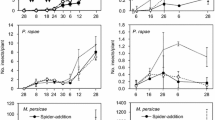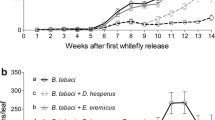Abstract
Syrphid flies are abundant in lettuce fields, where their larvae are key predators of aphids. However, the presence of predators in the field does not always result in economically significant levels of prey suppression. Even when predators are numerous, their effects on prey population dynamics may be variable. Over a two year period we surveyed lettuce fields in coastal California, USA to test whether syrphid flies are capable of colonizing fields with aphids and suppressing aphid population growth. The survey showed that female syrphids oviposited more eggs at locations with more aphids, and that greater numbers of syrphid larvae resulted in lower rates of increase in the aphid populations. We also directly manipulated syrphid densities by adding syrphid eggs to uncaged lettuce plants, and these syrphid additions resulted in lower aphid population growth. This research shows that syrphid flies have the ability to suppress aphid populations in lettuce fields.


Similar content being viewed by others
References
Adams THL, Chambers RJ, Dixon AFG (1987) Quantification of the impact of the hoverfly, Metasyrphus corollae on the cereal aphid, Sitobion avenae, in winter wheat: laboratory rates of kill. Entomol Exp Appl 43:153–157
Ambrosino MD, Jepson PC, Luna JM (2007) Hoverfly oviposition response to aphids in broccoli fields. Entomol Exp Appl 122:99–107
Berryman AA (1992) The origins and evolution of predator-prey theory. Ecology 73:1530–1535
Chambers RJ (1986) Preliminary experiments on the potential of hoverflies [Dipt.: Syrphidae] for the control of aphids under glass. Entomophaga 31:197–204
Fréchette B, Rojo S, Alomar O, Lucas É (2007) Intraguild predation between syrphids and mirids: who is the prey? Who is the predator? BioControl 52:175–191
Freier B, Triltsch H, Mowes M, Moll E (2007) The potential of predators in natural control of aphids in wheat: results of a ten-year field study in two German landscapes. BioControl 52:775–788
Furlong MJ, Zalucki MP (2010) Exploiting predators for pest management: the need for sound ecological assessment. Entomol Exp Appl 135:225–236
Gillespie M, Wratten S, Sedcole R, Colfer R (2011) Manipulating floral resources dispersion for hoverflies (Diptera: Syrphidae) in a California lettuce agro-ecosystem. Biol Control 59:215–220
Haenke S, Scheid B, Schaefer M, Tscharntke T, Thies C (2009) Increasing syrphid fly diversity and density in sown flower strips within simple vs. complex landscapes. J Appl Ecol 46:1106–1114
Hagen KS, Mills NJ, Gordh G, McMurtry JA (1999) Terrestrial arthropod predators of insect and mite pests. In: Bellows TS, Fisher TW (eds) Handbook of biological control. Academic Press, San Diego, USA, pp 383–503
Harwood JD, Obrycki JJ (2005) Quantifying aphid predation rates of generalist predators in the field. Eur J Entomol 102:335–350
Hogg BN, Nelson EH, Mills NJ, Daane KM (2011) Floral resources enhance aphid suppression by a hoverfly. Entomol Exp Appl 141:138–144
Hong BM, Hung HQ (2010) Effect of temperature and diet on the life cycle and predatory capacity of Episyrphus balteatus (De Geer) (Syrphidae: Diptera) cultured on Aphis gossypii (Glover). I. Int Soc Southeast Asian Agric Sci 16:98–103
Hopper JV, Nelson EH, Daane KM, Mills NJ (2011) Growth, development and consumption by four syrphid species associated with the invasive lettuce aphid, Nasonovia ribisnigri, in California. BioControl 58:271–276
Kindlmann P, Dixon AFG (2010) Modelling population dynamics of aphids and their natural enemies. In: Kindlmann P, Dixon AFG, Michaud JP (eds) Aphid biodiversity under environmental change. Springer, New York, USA, pp 1–20
Mayadunnage S, Wijayagunasekara H, Hemachandra K, Nugaliyadde L (2009) Occurrence of aphidophagous syrphids in aphid colonies on cabbage (Brassica oleracea) and their parasitoids. Trop Agric Res 21:99–109
Michaud JP, Belliure B (2001) Impact of syrphid predation on production of migrants in colonies of the brown citrus aphid, Toxoptera citricida (Homoptera: Aphididae). Biol Control 21:91–95
Nourbakhsh SH, Soleymannejadian E, Nemti AR (2008) Biology and population dynamics of Scaeva albomaculata (Diptera: Syrphidae) in almond orchards of Shahrekord. Iran J Entomol Soc Iran 27:93–108
Oelbermann K, Scheu S (2009) Control of aphids on wheat by generalist predators: effects of predator density and the presence of alternative prey. Entomol Exp Appl 132:225–231
Putra NS, Yasuda H (2006) Effects of prey species and its density on larval performance of two species of hoverfly larvae, Episyrphus balteatus de Geer and Eupeodes corollae Fabricius (Diptera: Syrphidae). Appl Entomol Zool 41:389–397
Rojo S, Gilbert F, Marcos-García MÁ, Nieto JM, Mier MP (2003) A world review of predatory hoverflies (Diptera, Syrphidae: Syrphinae) and their prey. Universidad de Alicante, Centro Iberoamericano de la Biodiversidad
Salveter R (1998) The influence of sown herb strips and spontaneous weeds on the larval stages of aphidophagous hoverflies (Dipt., Syrphidae). J Appl Entomol 122:103–114
Schmidt MH, Thewes U, Thies C, Tscharntke T (2004) Aphid suppression by natural enemies in mulched cereals. Entomol Exp Appl 113:87–93
Smith HA, Chaney WE (2007) A survey of syrphid predators of Nasonovia ribisnigri in organic lettuce on the Central Coast of California. J Econ Entomol 100:39–48
Smith HA, Chaney WE, Bensen TA (2008) Role of syrphid larvae and other predators in suppressing aphid infestations in organic lettuce on California’s central coast. J Econ Entomol 101:1526–1532
Soleyman-Nezhadiyan E, Laughlin R (1998) Voracity of larvae, rate of development in eggs, larvae and pupae, and flight seasons of adults of the hoverflies Melangyna viridiceps Macquart and Symosyrphus grandicornis Macquart (Diptera: Syrphidae). Aust J Entomol 37:243–248
Symondson WOC, Sunderland KD, Greenstone MH (2002) Can generalist predators be effective biocontrol agents? Ann Rev Entomol 47:561–594
Tenhumberg B, Poehling H-M (1995) Syrphids as natural enemies of cereal aphids in Germany: aspects of their biology and efficacy in different years and regions. Agric Ecosyst Environ 52:39–43
van Rijn PCJ, Kooijman J, Wäckers F (2006) The impact of floral resources on syrphid performance and cabbage aphid biological control. IOBC/WPRS Bull 29:149–152
Verma JS, Sharma KC (2006) Biology and predatory potential of Metasyrphus confrater (Wiedemann) on aphid, Macrosiphum rosae L. infesting Rosa spp. J Entomol Res 30:31–32
Wäckers FL (2005) Suitability of (extra-)floral nectar, pollen, and honeydew as insect food sources. In: Wackers FL, van Rijn PCJ, Bruin J (eds) Plant-provided food for carnivorous insects. Cambridge University Press, Cambridge, UK, pp 17–74
Walton NJ, Isaacs R (2011) Influence of native flowering plant strips on natural enemies and herbivores in adjacent blueberry fields. Environ Entomol 40:697–705
Wyss E, Villiger M, Muller-Scharer H (1999) The potential of three native insect predators to control the rosy apple aphid, Dysaphis plantaginea. BioControl 44:171–182
Acknowledgements
This work was funded by the National Research Initiative of the USDA National Institute of Food and Agriculture, grant 2008-35302-04677 and the USDA’s Western Regional Integrated Pest Management Program, grant 2008-34103-19414. Earthbound Farm and Enza Zaden Research provided field access and operational support. Julie Hopper provided the summary of instar-specific syrphid larval development times. We thank Adeline Abrams, Chris Battey, Alice Chen, Brianne Crabtree, Eve Roubinet, Korey Kassir, and Kevin Welzel for their assistance in the field and laboratory. The thoughtful comments of Matt Daugherty, three anonymous reviewers, and the coordinating editor greatly improved the quality of the manuscript.
Author information
Authors and Affiliations
Corresponding author
Additional information
Handling Editor: Arne Janssen.
Rights and permissions
About this article
Cite this article
Nelson, E.H., Hogg, B.N., Mills, N.J. et al. Syrphid flies suppress lettuce aphids. BioControl 57, 819–826 (2012). https://doi.org/10.1007/s10526-012-9457-z
Received:
Accepted:
Published:
Issue Date:
DOI: https://doi.org/10.1007/s10526-012-9457-z




